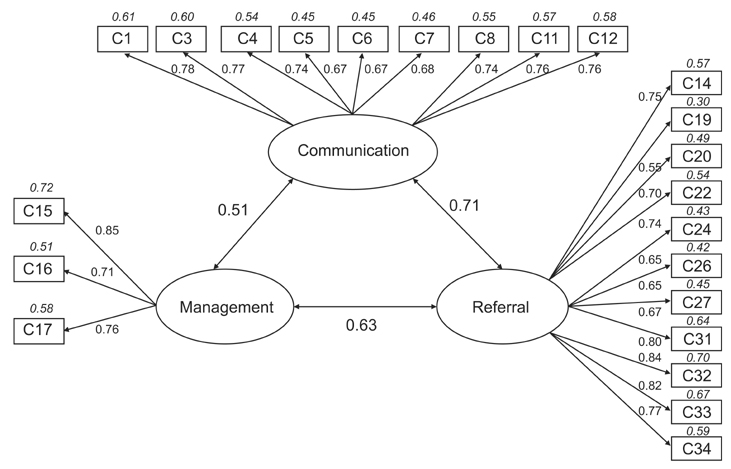Healthc Inform Res.
2016 Jul;22(3):206-216. 10.4258/hir.2016.22.3.206.
Revision of the Measurement Tool for Patients' Health Information Protection Awareness
- Affiliations
-
- 1College of Nursing, Chungnam National University, Daejeon, Korea.
- 2College of Nursing, Eulji University, Daejeon, Korea.
- 3Department of Nursing, Daejeon University, Daejeon, Korea.
- 4Department of Public Administration, Pai Chai University, Daejeon, Korea. hmlim@pcu.ac.kr
- KMID: 2357399
- DOI: http://doi.org/10.4258/hir.2016.22.3.206
Abstract
OBJECTIVES
Despite the importance of the protection of patients' health information in clinical settings, little is known about the awareness of this concept in nursing students due to the lack of a suitable measurement tool. Hence, this study attempted to redevelop the Patients' Health Information Protection Awareness Scale, and evaluate its construct validity and reliability for nursing students.
METHODS
A cross-sectional descriptive study was conducted. Nursing students who were in their 3rd and 4th year were recruited from 10 universities in Korea to assess the construct validity, and 30 experts (27 nurses and 3 faculty members) participated in the content validation process.
RESULTS
The content validity assessment indicated that 23 items were ideal. The assessment of construct validity using exploratory factor analysis revealed three factors: communication, management, and referrals. They together accounted for 54.1% of the variance in scale scores. The three-factor scale had good fit in the confirmatory factor analysis. Scale reliability was confirmed, with a Cronbach's alpha of 0.94 for all items.
CONCLUSIONS
This study was the first attempt to redevelop the Patients' Health Information Protection Awareness Scale for student nurses. The 23-item scale was shown to be a reliable and valid tool. It facilitates the assessment of nursing students' awareness of patient information protection. Academic nursing programs and health organizations can use its scores to implement adequate education plans to safeguard information in nursing students.
MeSH Terms
Figure
Reference
-
1. Haas S, Wohlgemuth S, Echizen I, Sonehara N, Muller G. Aspects of privacy for electronic health records. Int J Med Inform. 2011; 80(2):e26–e31.
Article2. Agrawal R, Johnson C. Securing electronic health records without impeding the flow of information. Int J Med Inform. 2007; 76(5-6):471–479.
Article3. Lee MY, Park YI. A study on the nurse's perception and performance of protecting patient privacy. Clin Nurs Res. 2005; 11(1):7–20.4. Kim CH, Jeong SY, Song YS. Recognition and performance of patient private information protection (PPIP) in nursing students. J Digit Policy Manag. 2013; 11(11):479–490.
Article5. Lee IH, Shin AM, Son CS, Park SY, Park HJ, Yoon KI, et al. Understanding the behavior of physical therapists and occupational therapists in protecting patient's medical information: an application of the theory of planned behavior. J Korean Soc Phys Ther. 2010; 22(2):55–60.6. Lee KH, Chung YC, Han KS, Song TM. Development and validation of privacy concern measurement tool in personal medical information. KIPS Trans Comput Commun Syst. 2014; 3(6):197–208.
Article7. Riordan F, Papoutsi C, Reed JE, Marston C, Bell D, Majeed A. Patient and public attitudes towards informed consent models and levels of awareness of Electronic Health Records in the UK. Int J Med Inform. 2015; 84(4):237–247.
Article8. Yang CM, Lin HC, Chang P, Jian WS. Taiwan's perspective on electronic medical records' security and privacy protection: lessons learned from HIPAA. Comput Methods Programs Biomed. 2006; 82(3):277–282.
Article9. Jung KI, Jung HY. A study on the student nurse's perception and performance protecting behavior for the patient medical information. Korean J Health Serv Manag. 2011; 5(4):65–79.
Article10. Buppert C. Safeguarding patient privacy. Establish department compliance with new federal regulations on individually identifiable health information. Nurs Manage. 2002; 33(12):31–35.11. Waltz CF, Strickland O, Lenz ER. Measurement in nursing and health research. 4th ed. New York (NY): Springer;2010.12. Polit DF, Beck CT, Owen SV. Is the CVI an acceptable indicator of content validity? Appraisal and recommendations. Res Nurs Health. 2007; 30(4):459–467.
Article13. Costello AB, Osborne JW. Best practice in exploratory factor analysis: four recommendations for getting the most from your analysis. Pract Assess Res Eval. 2005; 10(7):1–9.14. Thompson B, Daniel LG. Factor analytic evidence for the construct validity of scores: a historical overview and some guidelines. Educ Psychol Meas. 1996; 56(2):197–208.
Article15. Bentler PM. Comparative fit indexes in structural models. Psychol Bull. 1990; 107(2):238–246.
Article16. Schaufeli WB, Salanova M, Gonzalez-roma V, Bakker AB. The measurement of engagement and burnout: a two sample confirmatory factor analytic approach. J Happiness Stud. 2002; 3(1):71–92.17. Hu LT, Bentler PM. Cutoff criteria for fit indexes in covariance structure analysis: conventional criteria versus new alternatives. Struct Equ Modeling. 1999; 6(1):1–55.
Article18. Fornell C, Larcker DF. Evaluating structural equation models with observable variables and measurement error. J Mark Res. 1981; 18(1):39–50.
Article19. Nunnally JC, Bernstein IH. Psychometric theory. 3rd ed. New York (NY): McGraw-Hill;1994.20. O'Leary-Kelly SW, Vokurka RJ. The empirical assessment of construct validity. J Oper Manag. 1998; 16(4):387–405.21. Birch LL, Fisher JO, Grimm-Thomas K, Markey CN, Sawyer R, Johnson SL. Confirmatory factor analysis of the Child Feeding Questionnaire: a measure of parental attitudes, beliefs and practices about child feeding and obesity proneness. Appetite. 2001; 36(3):201–210.
Article22. The Office of the National Coordinator for Health Information Technology. Guide to privacy and security of health information (version 1.2). Washington (DC): US Department of Health and Human Services;2005.23. Harman LB, Flite CA, Bond K. Electronic health records: privacy, confidentiality, and security. Virtual Mentor. 2012; 14(9):712–719.
Article24. Kim SY, Shim JY, Won WJ, Sun WS, Park HK, Lee JK. The development of the Korean Health Related Quality of Life Scale (KQUOLS): testing reliability and validity. J Korean Acad Fam Med. 2000; 21(3):382–394.
- Full Text Links
- Actions
-
Cited
- CITED
-
- Close
- Share
- Similar articles
-
- Factors Associated with Practice of Health Information Protection among Nursing Students
- Development of a Measurement Tool System in Health and Medical Areas via the World Wide Web
- Knowledge and Practice of Dental Practitioners Regarding Patient's Personal Information
- Development of a Health Information Evaluation System On the Internet
- The need for developing guidelines for radiation protection in dental institutions


